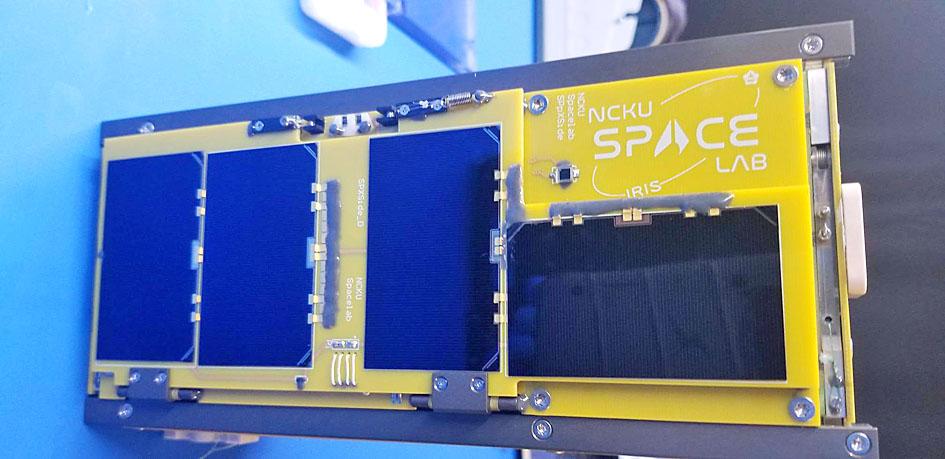Two Taiwanese space technology products developed by National Cheng Kung University (NCKU) and start-up Tensor Tech Co were yesterday launched by a SpaceX Falcon 9 rocket from Florida in a joint mission.
The Transporter-3 mission launched at 10:25am on Thursday at Cape Canaveral Space Force Station in Florida. The program put 105 small satellites into a sun-synchronous orbit at an altitude of 525km, NASASpaceflight.com says.
Among them was a cubesat — a small research satellite — named Iris-A, developed by NCKU electrical engineering professor Juang Jyh-ching (莊智清).

Photo courtesy of NCKU professor Juang Jyh-ching
Juang said that his team has received data transmitted by the cubesat via a ground station at the university’s campus in Tainan’s Gueiren District (歸仁).
The cubesat consists of a camera developed by Liscotech System Co, a long-range receiver by Letscom International Ltd, a GPS receiver by the National Space Organization (NSPO) and a reference clock by NCKU, according to Juang’s Space Lab Web site.
The GPS receiver in the cubesat is a miniaturized test model of what is to be used in NSPO Triton and Formosat-8 satellites to be launched at later dates, Juang said.
The cubesat is tasked with demonstrating Internet of Things (IoT) technology, including communication experiments using long-range delay tolerant network and Doppler compensation experiments, as well as testing the camera’s imaging capability, he said.
Iris-A is the first of a cubesat series, with Iris-B and Iris-C set to be launched at the end of this year or later, Juang said.
The launch mission also involves a novel attitude determination and control system (ADCS) developed by Tensor Tech, installed on Polish firm SatRevolution’s cubesat named Stork-1.
“This ADCS is actuated using a spherical motor with a rotor that can spin on multiple axes,” Tensor Tech said in a statement.
Conventional ADCS systems use three motors on three axes to rotate a satellite to a desired position, while Tensor Tech refined the functioning to one spherical motor to minimize the satellite’s weight, volume and power consumption, it said.
Stork-1 was designed to last three years, although its lifespan would be affected by a number of factors, said Tensor Tech cofounder and CEO Thomas Yen (顏伯勳).
The company is seeking clients in the US, Europe, Japan and India, and has discussed possible cooperation opportunities with local universities, Yen said.
Most Taiwanese businesses in the space-tech supply chain serve as OEM suppliers or satellite component producers, while the company aims to develop satellite subsystems or services to expand its market scope, he said.
The company could face challenges if it attempts to install the system on larger satellites, industry experts have said.
While the logic for controlling different satellites is the same, Tensor Tech will have to redesign the ADCS for larger satellites, which is one of the company’s goals, Yen said.
Founded in 2019, Tensor Tech branched from the laboratory of NCKU electrical engineering professor Hsieh Min-fu (謝旻甫), Yen said, adding that local electronics firms are its main investors.
The company has six full-time employees and two part-time workers, said 21-year-old Yen, who suspended his studies during his first year at National Taiwan University.

Three Taiwanese airlines have prohibited passengers from packing Bluetooth earbuds and their charger cases in checked luggage. EVA Air and Uni Air said that Bluetooth earbuds and charger cases are categorized as portable electronic devices, which should be switched off if they are placed in checked luggage based on international aviation safety regulations. They must not be in standby or sleep mode. However, as charging would continue when earbuds are placed in the charger cases, which would contravene international aviation regulations, their cases must be carried as hand luggage, they said. Tigerair Taiwan said that earbud charger cases are equipped

UNILATERAL MOVES: Officials have raised concerns that Beijing could try to exert economic control over Kinmen in a key development plan next year The Civil Aviation Administration (CAA) yesterday said that China has so far failed to provide any information about a new airport expected to open next year that is less than 10km from a Taiwanese airport, raising flight safety concerns. Xiamen Xiangan International Airport is only about 3km at its closest point from the islands in Kinmen County — the scene of on-off fighting during the Cold War — and construction work can be seen and heard clearly from the Taiwan side. In a written statement sent to Reuters, the CAA said that airports close to each other need detailed advanced

Tropical Storm Fung-Wong would likely strengthen into a typhoon later today as it continues moving westward across the Pacific before heading in Taiwan’s direction next week, the Central Weather Administration (CWA) said. As of 8am, Fung-Wong was about 2,190km east-southeast of Cape Oluanpi (鵝鑾鼻), Taiwan’s southernmost point, moving westward at 25kph and possibly accelerating to 31kph, CWA data showed. The tropical storm is currently over waters east of the Philippines and still far from Taiwan, CWA forecaster Tseng Chao-cheng (曾昭誠) said, adding that it could likely strengthen into a typhoon later in the day. It is forecast to reach the South China Sea

WEATHER Typhoon forming: CWA A tropical depression is expected to form into a typhoon as early as today, the Central Weather Administration (CWA) said yesterday, adding that the storm’s path remains uncertain. Before the weekend, it would move toward the Philippines, the agency said. Some time around Monday next week, it might reach a turning point, either veering north toward waters east of Taiwan or continuing westward across the Philippines, the CWA said. Meanwhile, the eye of Typhoon Kalmaegi was 1,310km south-southeast of Oluanpi (鵝鑾鼻), Taiwan’s southernmost point, as of 2am yesterday, it said. The storm is forecast to move through central